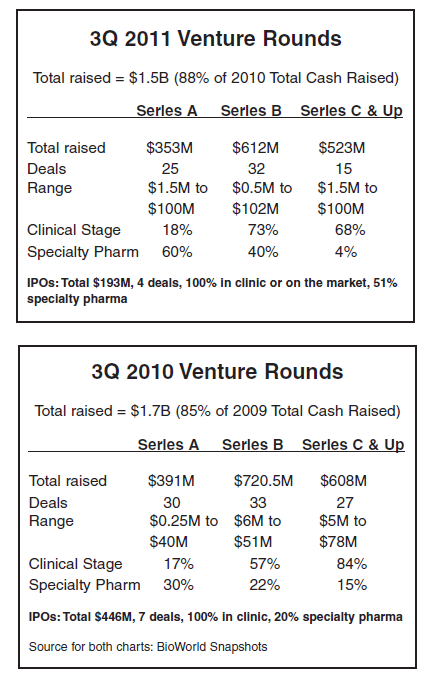BioWorld Today Columnist
The steady drip, drip, drip of excess stomach acid experienced by biotech venture capitalists, institutional investors and employees is sadly in sync with the steady drip, drip, drip of capital away from the sector.
So far, 2011 is looking even whimpier than 2010. Venture investing in biotech companies for the first three quarters of 2011 dropped 12 percent from last year – which was down 15 percent from 2009. Of course, $1.5 billion spread among 72 companies is still a meaningful amount of money. What remains to be seen is if the sector can hit its next fundable benchmarks and show biotech can be productive in spite of tight purses.
This year's Series A class saw a big uptick in investor preference for funding specialty pharma deals – 60 percent of the $353 million total for the class vs. 2010's 30 percent. Investors continued to prefer preclinical-stage opportunities, giving them $291 million of the $353 million total shoveled into the class. Interestingly, even though 15 percent less cash total flowed into the group, median deal size grew from $20 million in 2010 to $51 million in 2011. Presumably, investors are planning ahead for rocky markets and don't want product progress held back.
So how are things looking with the Series B deals? The trends closely resembled those seen in the younger company class. The group as a whole got 15 percent less cash vs. 2010, but median deal size doubled vs. 2010. There was a big jump in specialty pharma funding vs. companies working on novel products. Investors in this class strongly preferred companies already in clinical testing – 73 percent of the $612 million went into companies with candidates in human trials.
Those companies raising Series C rounds and higher were able to attract $523 million for only 15 deals. That is in stark contrast to the 27 deals completed last year, raising a total of $608 million. Most of the cash – 68 percent – flowed into clinical-stage companies working on novel products.
The Series C+ group is packed with companies who have been held out of the public markets – much to the chagrin of their private investors, and in spite of productive R&D teams – by an anemic initial public offering (IPO) marketplace. Four deals raised a measly $193 million, down 57 percent from 2010 third quarter when there were seven IPOs, which brought in $446 million.
Given the ongoing bipolar behavior of the public markets, there is little reason to feel hopeful about the rest of the calendar year.
Cynthia Robbins-Roth, PhD, founding partner of BioVenture Consultants, can be reached at biogodess@gmail.com. Her opinions do not necessarily reflect those of BioWorld Today.


